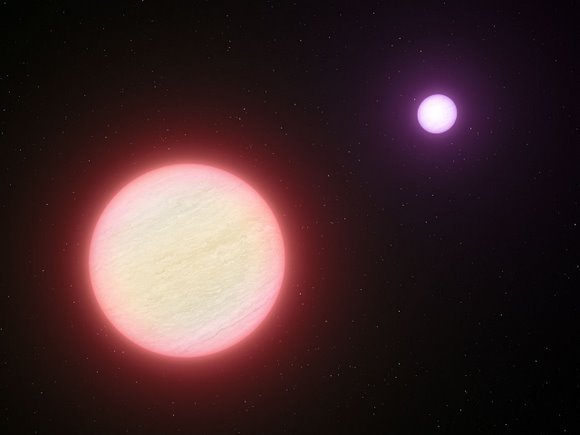
© ESO/L. CalçadaArtist's impression of the binary brown dwarf system CFBDSIR 1458+10.
Astronomers have found the coldest known star - a brown dwarf in a double system about as hot as a cup of tea. The discovery blurs the line between small cold stars and large hot planets. The star, CFBDSIR 1458+10B, is the dimmer member of the binary system, about 75 light-years from Earth.
Lead study author Michael Liu, from the University of Hawaii's Institute for Astronomy, said finding ever-cooler stars "has been one of the big themes of this field since it's existed in the last 15 years." Brown dwarfs are essentially failed stars; they lack enough mass for gravity to trigger the nuclear reactions that make stars shine. Liu said while the idea of a brown dwarf is many decades old, they were first confirmed in 1995, the same year the first gas giants were detected around other stars.
"Residing at the extremes of low mass, luminosity and temperature, brown dwarfs serve as laboratories for understanding gas-giant extrasolar planets as well as the faint end of the star formation process," write the authors in the new paper, in the Astrophysical Journal. "The coolest known brown dwarfs, the T dwarfs, have temperatures (~600 - 1400 K) ... that are more akin to Jupiter than any star."
Liu said cool brown dwarfs are exciting to find partly because they make great proxies for studying the mysteries of water cloud formation in the atmospheres of gas giants. Such clouds are believed to form when temperatures dip below 400 to 450 K.
"We probably will never get as detailed spectra from gas giants around other stars," he said, "because the planets are gravitationally bound to their stars. It's very hard to isolate the light from gas giant." But brown dwarfs more often occur in isolation.
Three different telescopes were used to study the system: the ESO's Very Large Telescope (VLT) in Chile, the Keck II Telescope in Hawaii and the Canada - France - Hawaii Telescope, also in Hawaii. The VLT was used to show that the composite object was very cool by brown dwarf standards.
"We were very excited to see that this object had such a low temperature, but we couldn't have guessed that it would turn out to be a double system and have an even more interesting, even colder component," said Philippe Delorme of the Institut de planétologie et d'astrophysique de Grenoble, a co-author of the paper.
CFBDSIR 1458+10 is the name of the binary system. The two components are known as CFBDSIR 1458+10A and CFBDSIR 1458+10B, with the latter the fainter and cooler of the two. They seem to be orbiting each other at a separation of about three times the distance between the Earth and the Sun in a period of about 30 years.
The dimmer of the two dwarfs has now been found to have a temperature of about 100 degrees Celsius, or about 370 K - the boiling point of water, and not much different from the temperature inside a sauna. By comparison the temperature of the surface of the Sun is about 5500 degrees Celsius.
The hunt for cool objects is a very active astronomical hot topic. The Spitzer Space Telescope has recently identified two other very faint objects as other possible contenders for the coolest known brown dwarfs, although their temperatures have not been measured so precisely. Future observations will better determine how these objects compare to CFBDSIR 1458+10B. Liu and his colleagues are planning to observe CFBDSIR 1458+10B again to better determine its properties and to begin mapping the binary's orbit, which, after about a decade of monitoring, should allow astronomers to determine the binary's mass.
Source: ESO
press release and a brief interview with lead author Michael Liu. See also the paper by Liu et al.,
"CFBDSIR J1458+1013B: A Very Cold (>T10) Brown Dwarf in a Binary System.''
Reader Comments
to our Newsletter